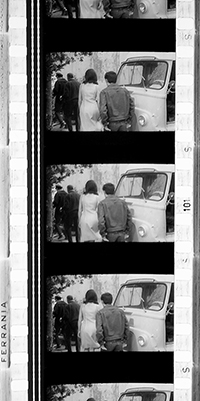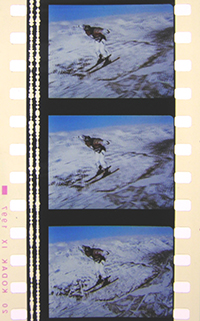|
|
This topic comprises 3 pages: 1 2 3
|
|
Author
|
Topic: Flat or 1.66
|
|
|
|
|
|
|
|
|
|
|
|
|
|
|
Randy Stankey
Film God

Posts: 6539
From: Erie, Pennsylvania
Registered: Jun 99
|
 posted 05-20-2013 01:34 AM
posted 05-20-2013 01:34 AM




"Flat" basically refers to any movie print which is not anamorphic or Cinemascope. ("Scope.")
Anamporphic, Cinemascope lenses have the property of magnifying images horizontally and vertically at different ratios. "Flat" or "spherical" lenses magnify images horizontally and vertically the same way.
Therefore, 1.85, 1.66, 1.78 and 1.37 aspect ratios are all considered "flat" because they don't use an anamorphic lens.
The different flat formats usually require a specific combination of lens focal length and aperture plate but it is often possible to project one flat format through a different lens/aperture combination with little or no noticeable difference. However, you might run into an objectionable cropping or image "spillover" situation when you do this.
Complicating the matter is the fact that some prints are "hard matted" with black bars between the frames. The image area of the film frame is supposed to match closely with the aperture/lens in order to fit onto the screen with minimal spillover.
This is where the funkiness comes in.
If you project a print composed in one aspect ratio using a projector set up for another, often, what you will find is that you have to be careful to frame the image properly or else you will cut off the tops of the characters' heads and their feet. Other times, you might be able to see microphone booms in the picture where you shouldn't.
Now, if the print is hard matted and you project in the wrong aspect ratio, you might end up with black bars at the top and bottom of the picture. The movie will look like it's been letterboxed when it really isn't supposed to be.
The best solution is to have the correct lens and aperture plates to project each format of movie at the right aspect ratio. If you can't afford more than one lens, it is possible to cut aperture plates for the different movies using only one lens. The down side, here, is that, unless your screen has moveable masking, the picture might not fit. If you can't do either of those things, the only thing you can do is to watch the movie closely and carefully adjust the framing as well as you can so that heads and feet are not cut off or so that extraneous objects don't show on the screen when they shouldn't.
Movies should be marked with the right aspect ratio. Often, it is marked right on the leader but, just as often, it is not. Sometimes, you can look the movie up on IMDB.com or other places to find the aspect ratio but you can't always count on that. In the end, you just have to be on the lookout and be ready to make adjustments on the fly.
This is one reason why I always insisted on pre-screening movies before showing to the public. It gives you a chance to discover problems like this and come up with a solution if you can. If you can't do that, just stay close to the projector for the first showing and be ready to fix a problem if you have to.
| IP: Logged
|
|
|
|
|
|
Leo Enticknap
Film God

Posts: 7474
From: Loma Linda, CA
Registered: Jul 2000
|
 posted 05-20-2013 04:31 AM
posted 05-20-2013 04:31 AM





The bottom line is that the matte (shape of the frame) on your actual print is not necessarily the one it is intended to be shown in. You will often find with 'flat' release prints that many shots have a 1.38 or even a full gate frame, but some processs shots (e.g. titles, dissolves, shots that incorporate CGI effects etc.) are matted to 1.85. That's because the movie was shot on a camera that had a a full aperture gate (because it's designed for use with flat and anamorphic lenses), and the shots that only needed timing in post-production were contact printed through every generation to the release print. The process shots, however, needed to be optically printed and/or have digital filmouts incorporated, and those introduced the matte of the actual ratio intended to be projected.
As others point out, if the aspect ratio the filmmakers want you to project it in isn't stated on the cans or leaders, it's either a case of trying to find it online, or making an educated guess. From the late '50s, Hollywood was using 1.85 pretty much exclusively. I can't think of any Hollywood movie that was actually intended to be projected in 1.66. 1.66 was used mainly, but not exclusively, in France.
Another complicating factor is that many features were made using the 'shoot to protect' technique. If, for example, you're shooting a movie that you know is going to be shown in theatres in the US, Europe and on television, you frame the action such that it can be shown in either 1.38 (without panning and scanning), 1.66 or 1.85 without the loss of vital action, even if you're framing for 1.85 looking its best. You're not going to be able to tell which just by examining the print.
Soundtracks:
quote: Terry Lynn-Stevens
We ran the print in A-Chain and noticed that is was mono (which would be correct). Question is, was the tracks on the print stereo with just the recording on the center channel?
I'm guessing you mean Dolby A-type?
You can tell whether a print is mono or SVA (stereo variable area) from a visual examination, but you can't distinguish between the different flavours of SVA. For example, this:

is a twin bilateral, optical mono track. Both of the two optical records are identical, and printing a mono track this way was invented in order to reduce noise compared to a single bilateral track (e.g. RCA Duplex). If you look through 10-20 feet of a typical print and the two tracks look consistently identical, it's mono.
This one...

...is stereo - the two tracks clearly have a different signal on them. There's no way of telling whether they're A-type without surround, A-type with, SR, Ultra Stereo, DTS Stereo or whatever. Given that The Shining was made long before SR was launched in 1988, then if your print has a visibly stereo track on it, then it's almost certainly A-type with surround (04).
| IP: Logged
|
|
|
|
|
|
|
|
|
|
|
|
All times are Central (GMT -6:00)
|
This topic comprises 3 pages: 1 2 3
|
Powered by Infopop Corporation
UBB.classicTM
6.3.1.2
The Film-Tech Forums are designed for various members related to the cinema industry to express their opinions, viewpoints and testimonials on various products, services and events based upon speculation, personal knowledge and factual information through use, therefore all views represented here allow no liability upon the publishers of this web site and the owners of said views assume no liability for any ill will resulting from these postings. The posts made here are for educational as well as entertainment purposes and as such anyone viewing this portion of the website must accept these views as statements of the author of that opinion
and agrees to release the authors from any and all liability.
|

 Home
Home
 Products
Products
 Store
Store
 Forum
Forum
 Warehouse
Warehouse
 Contact Us
Contact Us




 Printer-friendly view of this topic
Printer-friendly view of this topic















